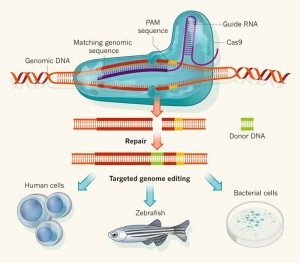CRISPR-Cas9 Genome editing
Jul 5, 2016 |
What's New
CRISPR (Clustered Regularly Interspaced Short Palindromic Repeat) is an RNA-guided gene-editing platform which with the help of Cas9 enzyme and guide RNA creates a double strand break at a specific location within the genome. It is the simplest, most versatile and precise method of genetic manipulation. You can use it to knock-out genes at the chromosomal level or knock in GFP reporter for promoter studies.
How does it work?

The CRISPR-Cas9 system consists of two key molecules that introduce a change /mutation into the DNA.
- An enzymecalled Cas9. This acts as a pair of molecular scissors that can cut ds DNA at a specific location in the genome.
- A piece of RNA called guide RNA (gRNA). This consists of a small piece of pre-designed RNA sequence (about 20 bases long, target sequence specific) located within a longer RNA scaffold. The scaffold binds to DNA and the pre-designed sequence guides Cas9 to the right part of the genome. This makes sure that the Cas9 enzyme cuts at the right point in the genome.
- At this stage the cellrecognizes that the DNA is damaged and tries to repair it. But since the repair machinery is not 100% efficient, there is a loss of a few nucleotides which disrupts gene activity.
- Scientists can use CRISPR-Cas9 to target and mutate one or more genes in the genome of a cell of interest in various organisms like bacteria, plants, C.elegans, mammalian cells and humans.
Read more…
Watch Video
